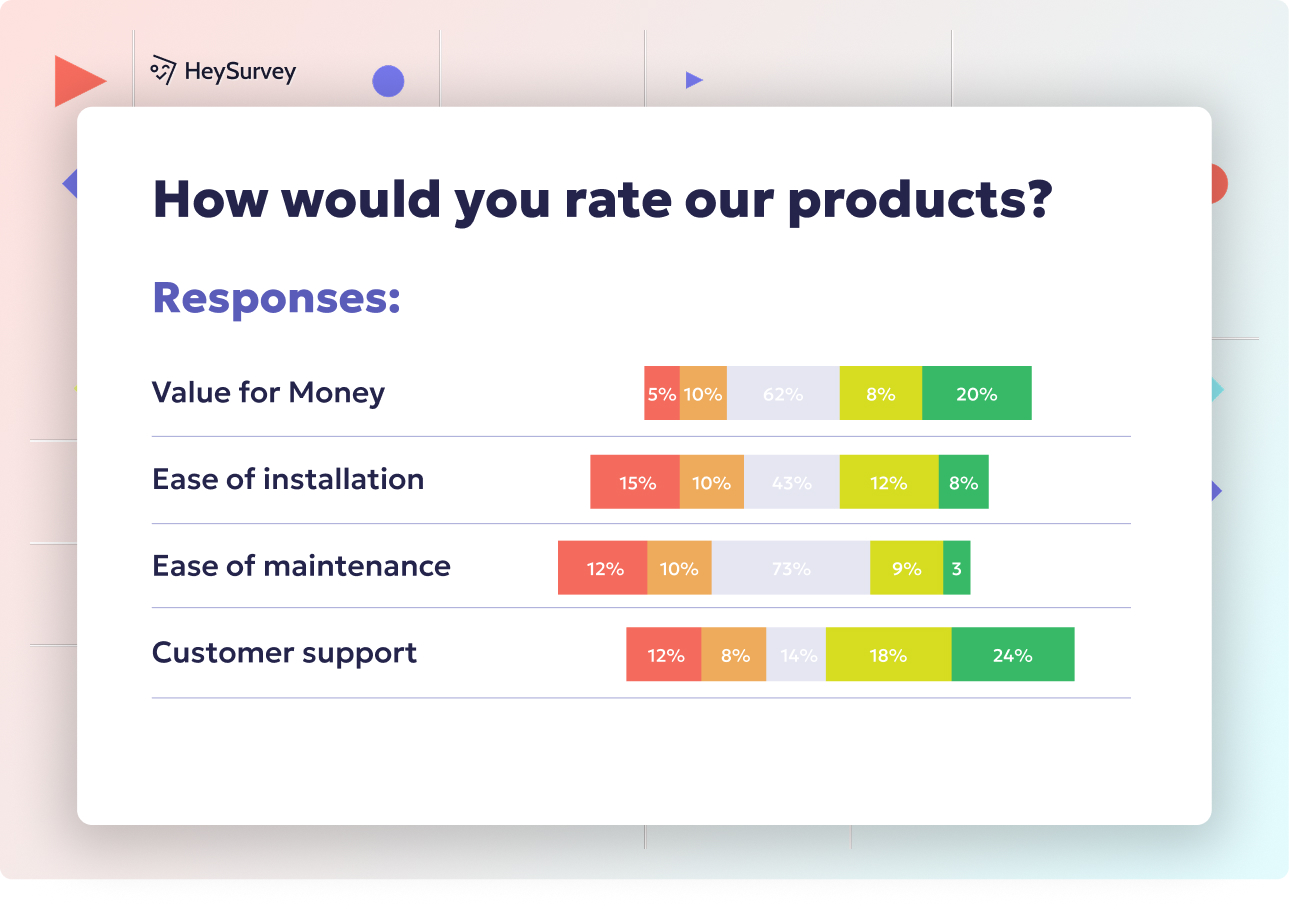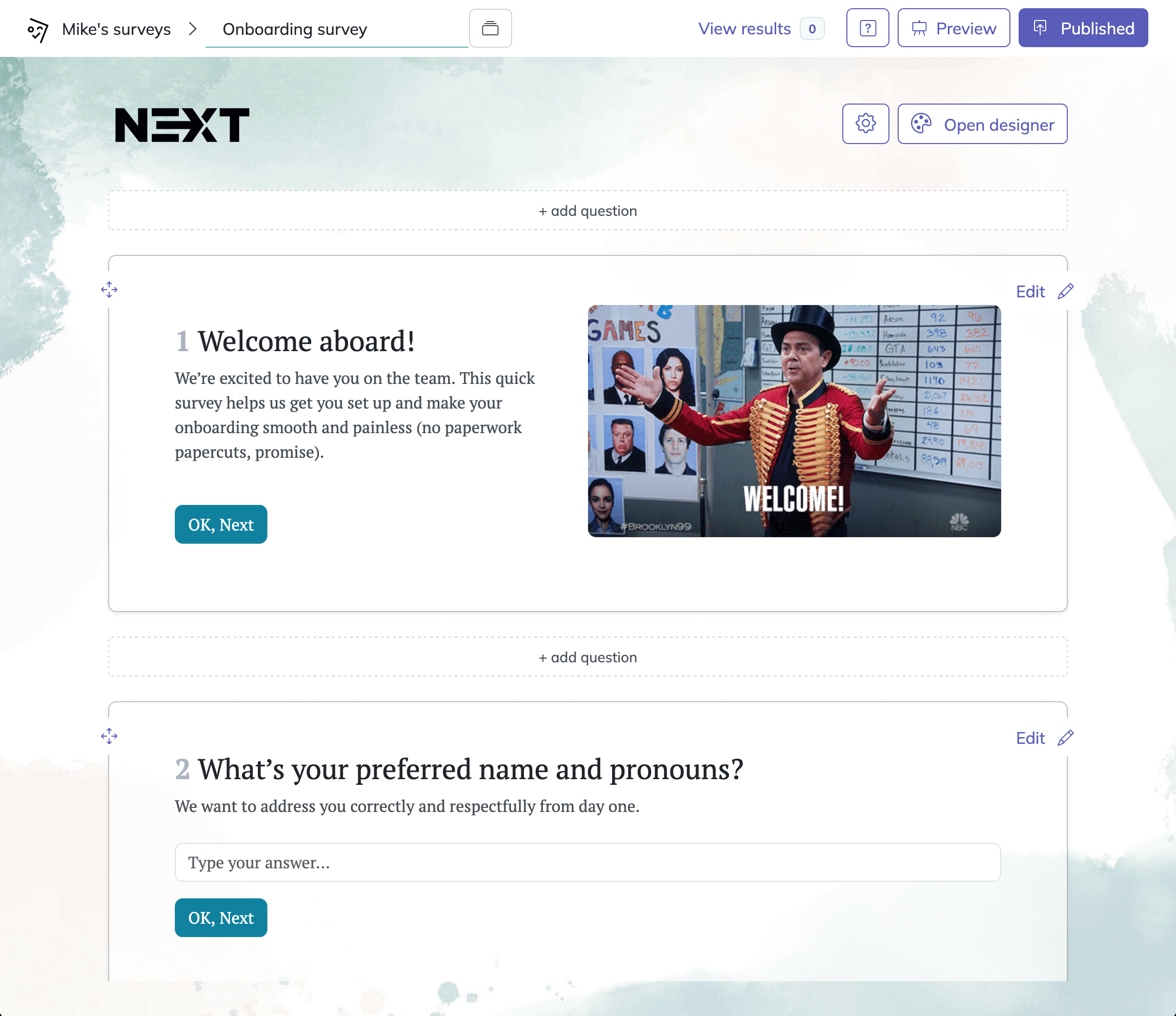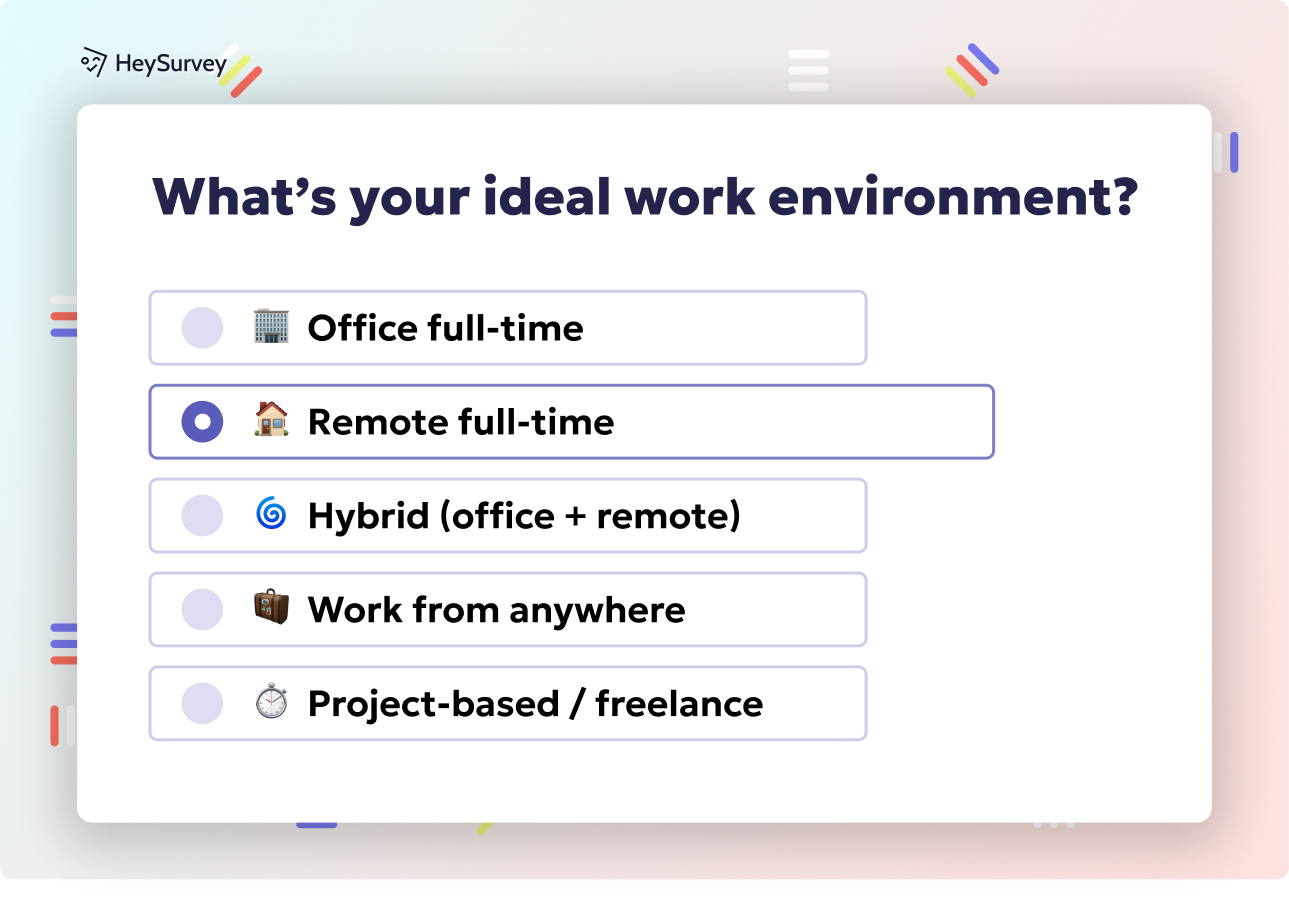32 Work-Life Balance Survey Questions: Types & Best Practices
Explore 25+ work life balance survey questions across 7 types to identify challenges and boost employee well-being and engagement effectively.
Work-life balance is more than a fuzzy buzzword—it's the not-so-secret sauce behind energized employees, stellar retention, and a magnetic employer reputation. When you zero in on the real roadblocks—overwork, fuzzy boundaries, and haphazard leadership—through targeted surveys, you uncover where things tip off balance. In this guide, you’ll discover seven tailored types of work-life balance survey questions and learn when, and how, HR teams should deploy each one for maximum impact.
Workload & Hours Satisfaction Survey
Why Focus on Workload and Hours?
The heart of work-life balance is how much work spills over into life outside the office (or home office). Too many late nights or skipped lunches? That’s where burnout brews, engagement fizzles, and productivity tanks.
After big changes—think mergers, layoffs, busy seasons, or strange spikes in overtime—this survey shines a light on how sustainable workloads truly are. You’ll hear if deadlines squeeze too tight or if teams are holding it together with nothing but caffeine and crossed fingers.
Prime Moments to Deploy
- Immediately after organizational restructuring that shuffles teams or roles.
- During fiscal year peaks, product launches, or holiday crunches.
- If time-tracking data exposes a new marathon of overtime.
Sample Questions
On average, how many hours per week do you work beyond your contracted hours?
Rate the reasonableness of your project deadlines.
How often do you skip or shorten breaks to meet workload demands?
Do you feel you have adequate resources to complete tasks within working hours?
How frequently do you receive last-minute assignments?
How confident are you in discussing workload issues with your team or manager?
What to Do After the Survey
When the results reveal stretched-to-the-limit staff, it’s time to spring into action. That could mean redistributing overstuffed task lists, nudging leaders to revisit resourcing, or even making the business case for extra hands on deck. If automation is an option, highlight bottlenecks that technology can ease—because no one wants to drown in spreadsheets.
Invite teams to co-create more reasonable expectations and adjust processes, so those heroic “just get it done” stories don’t become routine. Most of all, signal that this data isn’t just numbers—it’s the blueprint for fairer workweeks.
Approximately 50% of working women report feeling stressed "a lot of the day," compared to about 40% of men, highlighting significant gender disparities in work-life balance. (apnews.com)

Creating your work-life balance survey with HeySurvey is super easy—even if you’ve never built one before. Just follow these simple steps and you’ll be up and running in no time!
Step 1: Create a New Survey
- Head over to the HeySurvey website and click “Create New Survey.”
- You can choose to start with an empty sheet for total control or pick from a pre-built template to save time.
- If you’re aiming for something quick, try the text input creation, where you type your questions and HeySurvey formats them for you.
- Give your survey a name that helps you easily spot it later (something like “Work-Life Balance Pulse”).
Pro tip: If you're reading this on the HeySurvey site, look for the button below to open a ready-made template and skip some early setup steps!
Step 2: Add Your Questions
- Click “Add Question” to begin building your survey. You can add questions anywhere you want—at the top, bottom, or between existing ones.
- Pick from a variety of question types: Choice (single or multiple answers), Scale (perfect for stress or satisfaction ratings), Text (for open-ended feedback), or Statement (to share info without a question).
- Type in your question and add any helpful descriptions or instructions.
- Use the handy markdown formatting to make question text bold or italic—great for emphasizing key points.
- Mark important questions as required so respondents don’t skip them.
- Want to add images? Choose from HeySurvey’s built-in libraries or upload your own logos or photos.
- If some questions need to appear only if a certain answer gets picked, set up branching logic so your survey flows perfectly.
Step 3: Publish Your Survey
- When your questions are ready, hit the “Preview” button to see exactly how it’ll look for respondents. Check it on mobile and desktop!
- Once happy, click “Publish.” You’ll need to create a free HeySurvey account at this point to get access to responses.
- Get your survey link and share it via email, Slack, social media, or embed it right into your company site or intranet for easy access.
Bonus Step A: Apply Your Branding
- Upload your company’s logo to the top left corner of the survey for that professional touch.
- Customize colors, fonts, and backgrounds in the Designer Sidebar to match your brand vibe perfectly.
Bonus Step B: Define Survey Settings
- Set a start and end date if you want to make your survey available only for a limited time.
- Cap the number of responses to avoid overload if needed.
- Customize what respondents see after finishing—add a thank-you message or redirect them to your company homepage.
- Decide if you want respondents to view survey results or keep those private.
Bonus Step C: Use Branching or Skip Logic
- Tailor the respondent’s journey by skipping irrelevant questions based on their previous answers.
- Create multiple endings to offer personalized messages, making the survey feel more engaging and less like a chore.
With these simple steps, you’ll have a sleek, insightful work-life balance survey ready to gather real feedback and help make meaningful changes. Ready to get started? Click the template button below and take the first step!
Stress & Well-Being Pulse Survey
Why Stress Checks Matter
Even high performers crack if stress quietly piles up. Burnout isn’t always loud; it can be the regular, creeping exhaustion that makes people dread Mondays (and Tuesdays, and...). This survey is your early-warning system for burnout and chronic stress.
Deploy these quick check-ins monthly, quarterly, or after all-hands-on-deck efforts like a major product launch. You’re sending the message: “We care if you’re fried—not just if you’re productive.”
When to Use This Survey
- Monthly or quarterly—it’s the pulse check with highest ROI.
- After big pushes, like “crunch mode,” to catch burnt-out stars before they fade.
- When turnover ticks up for no obvious reason.
Sample Questions
How often do you feel mentally exhausted at the end of the workday?
Rate your current level of work-related stress.
How confident are you in accessing mental-health resources provided by the company?
In the past two weeks, how many times have you worked while sick?
How effective are your coping strategies during high-pressure periods?
How supported do you feel by your peers during stressful times?
Follow-Up Actions
Don’t just spot the smoke—look for the fire. If chronic stress is a pattern, it’s time for manager training in workload distribution or more transparent prioritization. Review your wellness programs: Are employees actually using them, and do people know they exist?
If people are pushing through illness or hiding burnout, break the taboo by launching open conversations and spotlighting well-being champions. A pulse survey is a check-in—not a fix—but acting on it tells everyone their energy matters as much as their output.
Approximately 50% of working women report feeling stressed "a lot of the day," compared to about 40% of men, highlighting significant gender disparities in work-life balance. (apnews.com)
Flexibility & Remote Work Experience Survey
Why Flexibility Rules
What once felt like a “perk” is now table stakes: teams expect choice in where, when, and how they get things done. Remote and hybrid work offers more autonomy, but it's not risk-free—especially if people feel isolated or boundaries start to blur.
When you’re rolling out or tweaking flex policies, a flexibility survey helps you zoom in on what’s working and where friction lurks.
When to Send It
- As policies evolve—before, during, and after deployment.
- When shifting headquarters, opening new offices, or expanding remote access.
- If feedback suggests home-office support or inclusivity gaps.
Sample Questions
Which work arrangement (office, hybrid, remote) best supports your productivity?
Rate the support you receive for home-office equipment expenses.
How easy is it to adjust your schedule for personal commitments?
Do you feel remote work blurs the boundaries between work and personal life?
How inclusive are meetings for teammates across time zones?
Do you have equal opportunities for growth, regardless of work location?
What’s Next?
Listen for both cheers and warning bells. If people pine for the office, dig deeper: Is it camaraderie, setup, or just FOMO? If boundaries blur, introduce “right to disconnect” norms or encourage more mindful scheduling.
Fine-tune stipend processes for home-office gear, or standardize flexible arrangements. At every step, act on the feedback—nothing is more deflating than surveying remote workers and then ghosting their ideas.
Managerial Support & Communication Survey
Why Managerial Support Is Non-Negotiable
Managers are the thermostat for work-life balance. One supportive boss can offset a mountain of pressure, while a single “always-on” leader can torch team morale.
This survey pinpoints whether direct supervisors walk the talk: Do they urge team members to unplug, model balance, and clarify priorities, or do they quietly nudge people toward more hustle?
When to Deploy
- Fold it into annual check-ins and 360-reviews.
- After management shake-ups, promotions, or new leadership training cycles.
- When exit interviews hint at rocky supervisory relationships.
Sample Questions
My manager encourages me to disconnect outside working hours.
How approachable is your manager regarding workload concerns?
Does your manager model healthy work-life balance behaviors?
How often does your manager respect scheduled PTO without contacting you?
Rate the clarity of priorities your manager provides.
How frequently does your manager recognize boundaries between urgent and non-urgent requests?
Acting on the Answers
If you spot trouble, train up your managers! Provide scripts and playbooks for discussing workload. Shine a spotlight on managers who model healthy disconnecting and share their best practices.
If team members clock managers pinging them on weekends or ignoring PTO, address it fast—privately but directly. Give managers easy-to-use tools for setting realistic goals and show them how balance boosts, not breaks, productivity.
Supervisor support significantly enhances employees' work-life balance, leading to improved job satisfaction and organizational commitment. (emerald.com)
Organizational Culture & Boundary-Setting Survey
Unwritten Rules Matter
Policies might say, “Work ends at five,” but culture says who actually leaves at five. The unwritten rules—late-night emails, skipped lunches, silent pressure—shape whether people truly believe they’re allowed to step away.
During growth spurts, mergers, or conscious efforts to reshape culture, this survey is your magnifying glass for those shadow norms.
Best Timing for This Survey
- During active culture-building or after blending teams post-merger.
- If employee feedback hints at unspoken “always-on” expectations.
- When formal policies (PTO, breaks) aren’t translating into behavior.
Sample Questions
How acceptable is it to disconnect from email/slack after work hours?
Describe the pressure you feel to respond to messages immediately.
Do senior leaders openly take and honor vacation time?
How valued is taking lunchtime away from your desk?
Rate how well company policies align with actual day-to-day practices.
How do celebrations or recognition events respect employee time outside work?
How to Respond
If unwritten norms undermine policies, name the elephants in the room. Encourage visible leadership buy-in: let leaders walk out for lunch, burn their own PTO, and celebrate others who do the same.
Revisit after-hours notification policies or calendar “quiet hours.” Make it easy—and expected—for teams to log off. Signal that actual well-being trumps performative dedication, and make those values impossible to miss.
Career Development vs Personal Life Alignment Survey
Why Development and Downtime Must Coexist
It shouldn’t take superpowers to upskill without burning out. If professional development is a ladder you climb at the expense of nights, weekends, or life milestones, people will sooner or later drop the ladder—or leave.
When launching new career tracks, training marathons, or revamped performance reviews, this survey ensures advancement doesn’t trample on personal commitments.
Perfect Use Cases
- Before rolling out large-scale learning or upskilling programs.
- When promotion paths or skills frameworks get a major revamp.
- If you hear rumblings about training formats or inflexible session times.
Sample Questions
Can you pursue professional development without sacrificing personal time?
How flexible are training sessions (formats, timing)?
Rate the support you receive to attend external courses during work hours.
Do promotion paths consider output quality rather than sheer time input?
Have you postponed family plans due to career expectations here?
How well do personal and professional growth opportunities align with your goals?
Taking Action
If you discover talent development is running roughshod over lives, adjust the pace. Offer on-demand or asynchronous learning, make room in work hours for skill-building, and ensure managers support both.
Reward smart, not just long work, and put quality over face time in promotion criteria. Communicate clearly that balance boosts growth, not the other way around.
Time-Off & Recovery Survey
Why Time-Off Isn’t a Nice-to-Have
Regular, restorative time off—it’s the secret ingredient for sustained energy and creativity. But if taking PTO, parental leave, or even mini-breaks feels risky or pointless, you’ll see fatigue, resentment, and even “quiet quitting.”
Conduct this survey before revising policies, when utilization plummets, or simply as a mid-year check-in. It will reveal where rigid practices, subtle stigma, or clunky approval processes still hold sway.
When to Use This Survey
- As part of mid-year wellness pulses or before big PTO policy updates.
- If reports of unused or rolled-over PTO spike.
- After new policies (unlimited PTO, expanded leave) roll out.
Sample Questions
How easy is it to request and secure approval for time off?
To what extent do you disconnect fully during vacation?
Have you ever postponed PTO due to workload concerns?
Rate the adequacy of company policy for parental or caregiver leave.
How supported do you feel upon returning from extended leave?
How often do you take short breaks during the workday?
Post-Survey Steps
If time off feels impossible, make the process clearer and smoother. Normalize using PTO—and not just in PowerPoint slides. Train managers to cover absences and model their own downtime. If people struggle to disconnect, consider digital detox incentives or auto-snooze features for notifications.
When employees return after leave, ensure reboarding and support so they aren’t swimming upstream from day one. Nothing says “we care” like championing rest and recovery for every team member.
Best Practices: Dos and Don’ts for Crafting Effective Work-Life Balance Surveys
Survey Design—Set Up Success
To unlock actionable insights, segment results by department, tenure, or location. This helps reveal pockets of friction and tailored opportunities for change.
Don’t fire off a marathon survey—keep it under 10 minutes! Employees love brevity and clarity, and you’ll win more honest responses. Opt for anonymous surveys to help people speak up, and always communicate exactly how confidentiality is protected.
Do segment surveys by department and tenure for actionable, targeted insights.
Do limit the survey length to less than 10 minutes to boost completion rates.
Do run anonymous surveys and clearly communicate confidentiality.
Do signal post-survey steps in advance for transparency and accountability.
Don’t bury the most sensitive or vulnerable questions at the top—warm up with lighter items first.
Don’t collect data without a plan to act, and always share key findings back with employees.
Don’t use jargon or alienating phrasing—inclusive, relatable language wins hearts and data.
Use mobile-responsive designs for maximum accessibility, because work-life balance means having choices—even on survey platforms! Choose the ideal cadence for your surveys, avoiding excessive frequency that breeds survey fatigue.
Benchmark your metrics against industry norms. This illuminates if you’re lagging, leading, or hitting the mark, so leadership can compare apples to apples.
Above all: Make sure every question serves a clear purpose and “close the loop” with follow-up action. The quickest way to crush trust? Ghosting on survey results—don’t be that employer.
Surveys are the starting line for culture change, not the finish line.
A healthy work-life balance doesn’t happen by accident. By choosing the right survey for each scenario, you reveal the friction points that matter most. Acting swiftly on results shows teams you value their whole well-being—not just their output. Master each survey type, keep communication open, and you’ll not only attract but keep the very best talent out there. Empowered teams build unstoppable companies.
Related Employee Survey Surveys

29 Essential Post Mortem Survey Questions for Project Success
Discover 25+ essential post mortem survey questions to improve projects, boost team morale, and d...

31 Change Readiness Survey Questions to Boost Your Success
Discover 25+ sample change readiness survey questions to assess attitudes, barriers, and confiden...

31 Retreat Survey Questions to Collect Actionable Feedback
Discover 26 essential retreat survey questions to gather actionable feedback before, during, and ...

